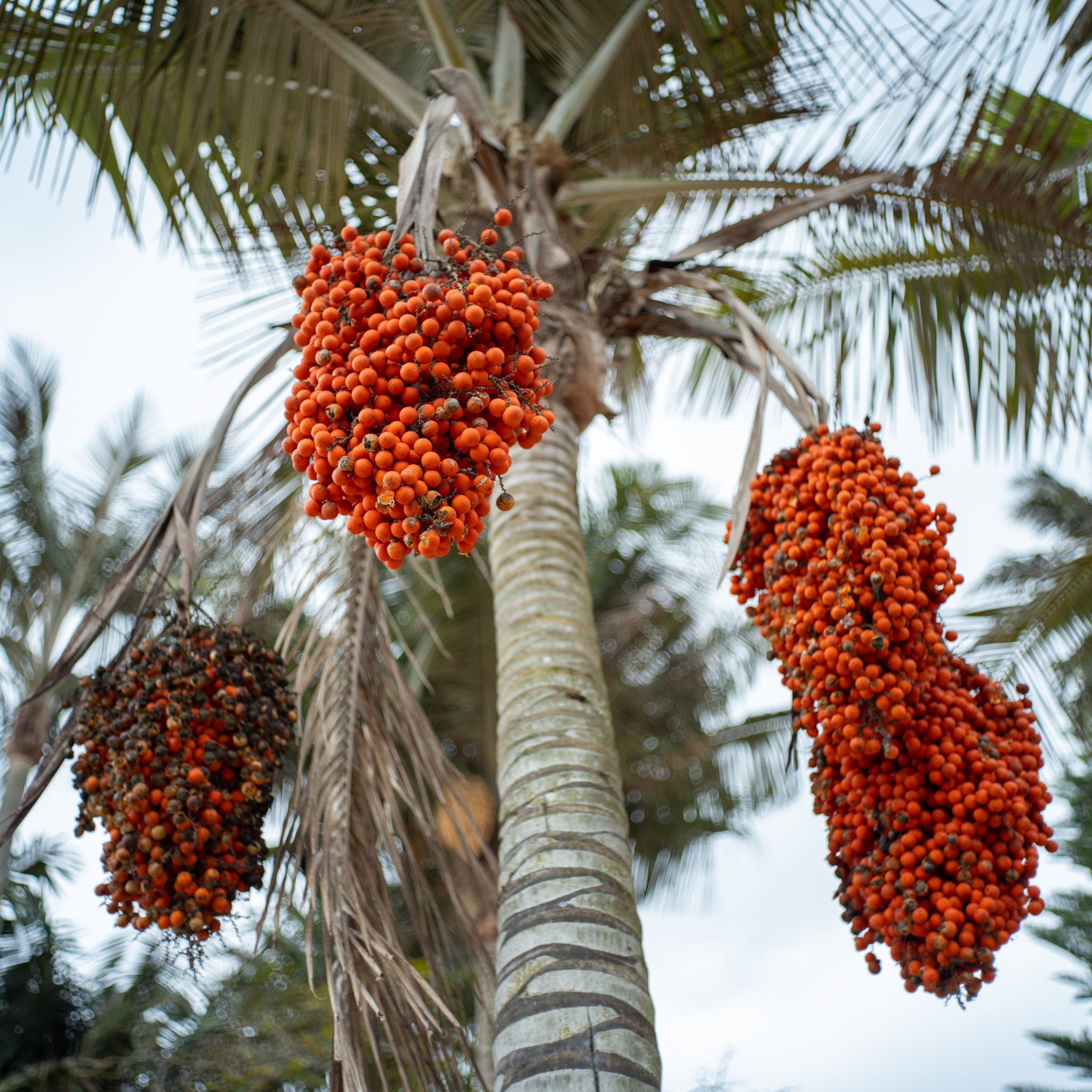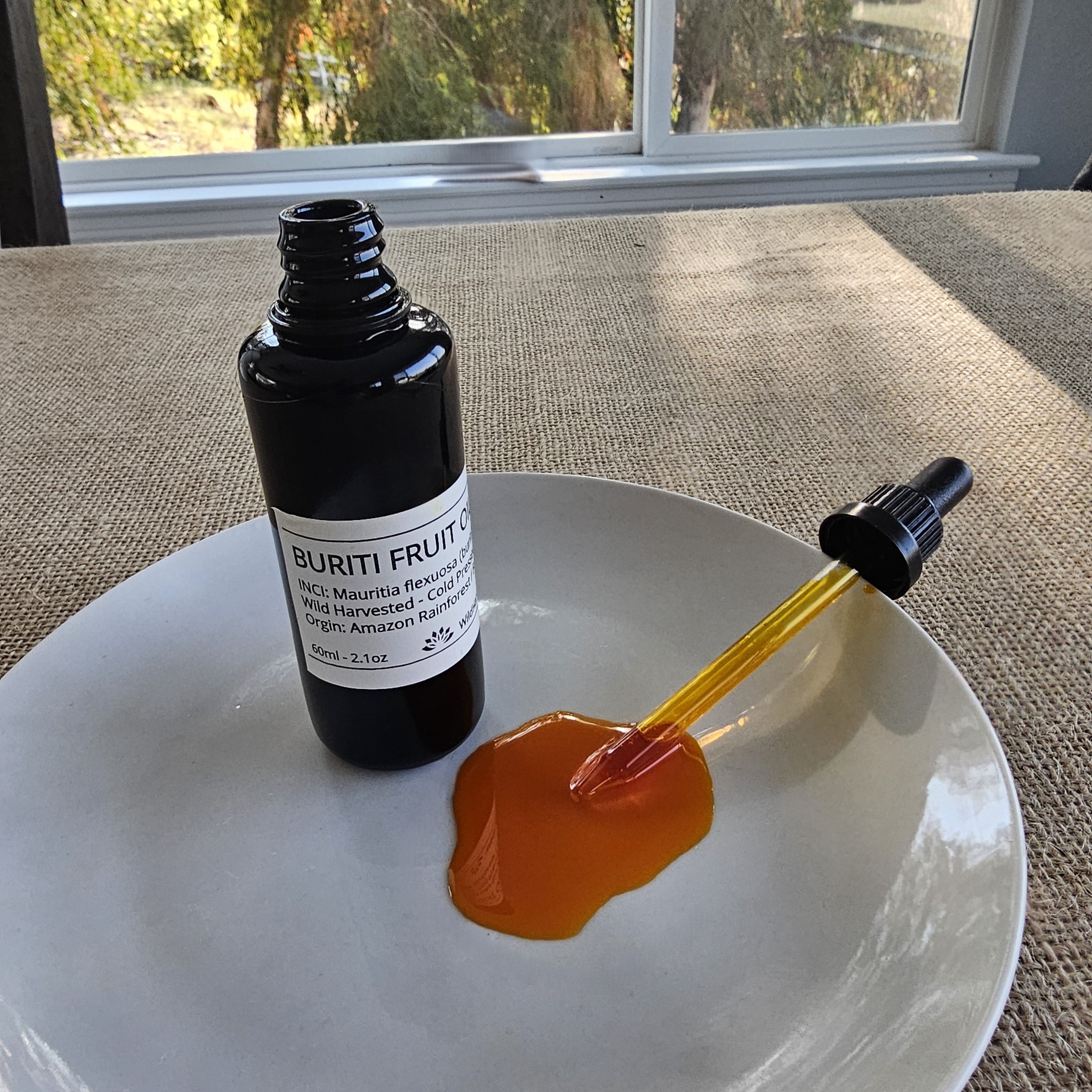Buriti oil is a vibrant, nutrient-rich oil extracted from the fruit of the buriti palm (Mauritia flexuosa), a towering tree native to the Amazon rainforest and other wetland regions of South America, often called the "tree of life" by local communities. The oil comes specifically from the reddish-orange pulp of the fruit, which is cold-pressed to yield a deep orange-to-reddish liquid with a mild, earthy, or slightly nutty scent. This striking color is a clue to its high concentration of carotenoids, particularly beta-carotene, which gives it both its hue and potent antioxidant properties. * (see carotenoids info below)
The buriti palm thrives in swampy, flooded areas, and its fruit has long been a staple for indigenous Amazonian peoples, who use it for food, medicine, and skincare. The oil has gained global attention in recent years for its versatility in cosmetics and natural health products.
Key Properties and Uses:
- Rich in Antioxidants: Buriti oil is loaded with beta-carotene (a precursor to vitamin A), tocopherols (vitamin E), and other antioxidants. These help neutralize free radicals, protecting skin and hair from oxidative stress caused by sun exposure, pollution, or aging.
- Moisturizing: High in oleic acid (an omega-9 fatty acid), it deeply hydrates and softens skin, making it a go-to for dry or damaged skin and hair.
- Sun Protection: The carotenoids may offer mild natural UV-filtering properties, though it’s not a substitute for sunscreen. It’s often used to soothe and repair sun-damaged skin after exposure.
- Anti-Aging: Its antioxidant and fatty acid content supports skin elasticity, reduces the appearance of fine lines, and promotes a healthy glow, earning it a spot in anti-aging creams and serums.
- Hair Care: It revitalizes dry, brittle, or color-treated hair by locking in moisture and adding shine, often found in conditioners or hair masks.
- Healing: Traditionally applied to burns, cuts, or irritated skin, it’s believed to aid in tissue repair and reduce inflammation.
Practical Applications:
- Cosmetics: A star ingredient in lotions, lip balms, sunscreens, and hair products for its nourishing and protective qualities.
- Culinary: While the oil itself isn’t typically ingested, the fruit pulp is eaten or used in beverages and desserts in Amazonian cuisine.
- Sustainability: Harvesting buriti supports local economies and rainforest preservation, as the tree isn’t felled to collect its fruit—just the fallen or ripe ones are gathered.
Fun Fact:
Buriti oil’s beta-carotene content is among the highest of any natural oil—up to five times more than carrot seed oil—making it a powerhouse for skin health. Its vivid color can stain, so it’s often diluted or blended in formulations.
It’s generally safe for topical use, with no major side effects reported, though patch-testing is wise for sensitive skin. Scientific studies on its benefits are still catching up to traditional wisdom, but its chemical profile backs up many of the claims. If you’re looking to try it, seek cold-pressed, unrefined versions to get the full spectrum of its goodness—perfect for a DIY beauty boost or straight from a bottle sourced from the Amazon!
Carotenoids in Buriti Oil:
- Buriti oil is renowned for its exceptionally high carotenoid content, which sets it apart from many other natural oils and gives it both its vivid reddish-orange color and significant health benefits. Carotenoids are a class of naturally occurring pigments synthesized by plants, algae, and some microorganisms. In the case of buriti oil, extracted from the fruit pulp of the Mauritia flexuosa palm (native to the Amazon), these compounds are present in abundance, making it a standout source among plant-based oils.
The primary carotenoid in buriti oil is beta-carotene, a provitamin A carotenoid, meaning the body can convert it into vitamin A (retinol) as needed. Alongside beta-carotene, buriti oil contains smaller amounts of other carotenoids like alpha-carotene and possibly traces of lycopene or lutein, though beta-carotene dominates the profile. Exact concentrations vary depending on factors like fruit maturity, growing conditions, and extraction methods, but studies indicate buriti oil can contain 150–300 mg of carotenoids per 100 grams of oil—exceptionally high compared to other sources.
For context:
- Carrot seed oil, another carotenoid-rich oil, typically has around 30–50 mg/100g of beta-carotene.
Buriti oil’s carotenoid levels can be 5–10 times higher than carrots themselves, often cited at 20–60 mg/100g in raw carrots.
This makes buriti oil one of the richest natural sources of carotenoids known, rivaled only by certain algae extracts or palm oil (from Elaeis guineensis), though buriti’s profile is distinct due to its Amazonian origin and broader nutrient mix.
Fatty Acid Profile for Mauritia Flexuosa (Buriti) Fruit Oil
















